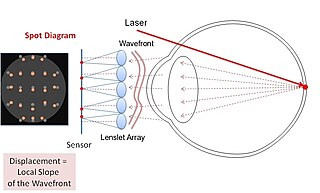 W
WAn autocollimator is an optical instrument for non-contact measurement of angles. They are typically used to align components and measure deflections in optical or mechanical systems. An autocollimator works by projecting an image onto a target mirror and measuring the deflection of the returned image against a scale, either visually or by means of an electronic detector. A visual autocollimator can measure angles as small as 1 arc-second, while an electronic autocollimator can have up to 100 times more resolution.
 W
WEllipsometry is an optical technique for investigating the dielectric properties of thin films. Ellipsometry measures the change of polarization upon reflection or transmission and compares it to a model.
 W
WA microdensitometer is an optical instrument used to measure optical densities in the microscopic domain. A well-known microdensitometer, used in the photographic industry, is a granularity instrument or granularity machine. The granularity measurement involves the use of an optical aperture, 10-50 micrometers in diameter, and in the recording of thousands of optical density readings. The standard deviation of this series of measurements is known as the granularity of the measured transmission surface, optical film, or photographic film, in particular.
 W
WIn optics, various autocorrelation functions can be experimentally realized. The field autocorrelation may be used to calculate the spectrum of a source of light, while the intensity autocorrelation and the interferometric autocorrelation are commonly used to estimate the duration of ultrashort pulses produced by modelocked lasers. The laser pulse duration cannot be easily measured by optoelectronic methods, since the response time of photodiodes and oscilloscopes are at best of the order of 200 femtoseconds, yet laser pulses can be made as short as a few femtoseconds.
 W
WAn optical chopper is a device which periodically interrupts a light beam. Three types are available: variable frequency rotating disc choppers, fixed frequency tuning fork choppers, and optical shutters. A rotating disc chopper was famously used in 1849 by Hippolyte Fizeau in the first non-astronomical measurement of the speed of light.
 W
WPhotometria is a book on the measurement of light by Johann Heinrich Lambert published in 1760. It established a complete system of photometric quantities and principles; using them to measure the optical properties of materials, quantify aspects of vision, and calculate illumination.
 W
WPhoton counting is a technique in which individual photons are counted using a single-photon detector (SPD). In contrast to a normal photodetector, which generates an analog signal proportional to the photon flux, a single-photon detector emits a pulse of signal every time a photon is detected. The total number of pulses is counted, giving an integer number of photons detected per measurement period. The counting efficiency is determined by the quantum efficiency and any electronic losses that are present in the system.
 W
WSensitometry is the scientific study of light-sensitive materials, especially photographic film. The study has its origins in the work by Ferdinand Hurter and Vero Charles Driffield with early black-and-white emulsions. They determined how the density of silver produced varied with the amount of light received, and the method and time of development.
 W
WA Shack–Hartmann wavefront sensor (SHWFS) is an optical instrument used for characterizing an imaging system. It is a wavefront sensor commonly used in adaptive optics systems. It consists of an array of lenses of the same focal length. Each is focused onto a photon sensor. If the sensor is placed at the geometric focal plane of the lenslet, and is uniformly illuminated, then, the integrated gradient of the wavefront across the lenslet is proportional to the displacement of the centroid. Consequently, any phase aberration can be approximated by a set of discrete tilts. By sampling the wavefront with an array of lenslets, all of these local tilts can be measured and the whole wavefront reconstructed. Since only tilts are measured the Shack–Hartmann cannot detect discontinuous steps in the wavefront.
 W
WIn ultrafast optics, spectral phase interferometry for direct electric-field reconstruction (SPIDER) is an ultrashort pulse measurement technique originally developed by Chris Iaconis and Ian Walmsley.
 W
WA streak camera is an instrument for measuring the variation in a pulse of light's intensity with time. They are used to measure the pulse duration of some ultrafast laser systems and for applications such as time-resolved spectroscopy and LIDAR.
 W
WVeiling glare is an imperfection of performance in optical instruments arising from incoming light that strays from the normal image-forming paths, and reaches the focal plane. The effect superimposes a form of noise onto the normal image sensed by the detector, resulting in a final image degraded by loss of contrast and reduced definition.